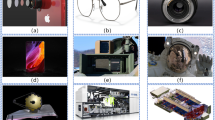Abstract
Mid-high spatial frequency errors are often induced on optical surfaces polished by computer-controlled optical surfacing (CCOS) processes. In order to efficiently remove these errors, which would degrade the performances of optical systems, the ability of a CCOS process to correct the errors have been investigated based on the convolution integral model in view of the availability of material removal. To quantify the ability, some conceptions, such as figure correcting ability and material removal availability (MRA), have been proposed. The research result reveals that the MRA of the CCOS process to correct a single spatial frequency error is determined by its tool removal function (TRF), and it equals the normalized amplitude spectrum of the Fourier transform of its TRF. Finally, three sine surfaces were etched using ion beam figuring (IBF), which is a typical CCOS process. The experimental results have verified the theoretical analysis. The employed method and the conclusions of this work provide a useful mathematical basis to analyze and optimize CCOS processes.
Similar content being viewed by others
References
Jones R A. Optimization of computer controlled polishing. Appl Opt, 1977, 16(1): 218–224
Zhang F, Yu J C, Zhang X J. Magnetorheological finishing technology (in Chinese). Opt Precision Eng, 1999, 7(5): 1–7
Dai Y F, Zhou L, Xie X H, et al. Realization of deterministically figuring in optics machining by ion beam (in Chinese). Acta Opt Sinica, 2008, 28(6): 1131–1135
Fan B, Wan Y J, Chen W, et al. Manufacturing features comparing between computer control active-lap and computer control optical surface for large aspheric optics (in Chinese). Chin J Lasers, 2006, 33(1): 128–132
Gao B, Yao Y X, Xie D G, et al. Movement modeling and simulation of precession mechanisms for bonnet tool polishing (in Chinese). Chin J Mech Eng, 2006, 42(2): 101–104
Guo P J, Fang H, Yu J C. Research on material removal mechanism of fluid jet polishing (in Chinese). Laser J, 2008, 29(1): 25–27
Bielke A, Bechstette K, Kübler C. Fabrication of aspheric optics-process challenges arising from a wide range of customer demands and diversity of machine technologies. In: Proceedings of SPIE. SPIE, 2004, 5252: 1–12
Taylor J S, Sommargren G E, Sweeney D W, et al. Fabrication and testing of optics for EUV projection lithography. In: Proceedings of SPIE. SPIE, 1998, 3331: 580–590
Lawson J K, Worfe C R, Manes K R, et al. Specification of optical components using the power spectral density function. In: Proceedings of SPIE. SPIE, 1995, 2536: 38–50
Schinhaerl M, Rascher R, Stamp R, et al. Utilisation of time-variant influence functions on the computer controlled polishing. Prec Eng, 2008, 32(1): 47–54
Drueding T W, Bifano T G, Fawcett S C. Contouring algorithm for ion figuring. Prec Eng, 1995, 17(1): 10–21
Cheng H B, Sun G Z, Feng Z J. Solving the input data in error corrction of optical fabrication by finite Fourier coefficient algorithm. Sci China Ser E-Tech Sci, 2006, 49(1): 50–60
Zhou L, Xie X H, Dai Y F, et al. Ion beam figuring system in NUDT. In: Proceedings of SPIE. SPIE, 2007, 6722: 67224A-1–67224A-6
Zhou L. Study on Theory and Technology in Ion Beam Figuring for Optical Surfaces (in Chinese). Dissertation of Doctoral Degree. Changsha: National University of Defense Technology, 2008. 4
Ghigo M, Canestrari R, Spiga D, et al. Correction of high spatial frequency errors on optical surfaces by means of ion beam figuring. In: Proceedings of SPIE. SPIE, 2007, 6671: 667114
Author information
Authors and Affiliations
Corresponding author
Additional information
Supported by the National Basic Research Program of China (“973” Project) and the National Natural Science Foundation of China (Grant No. 50775215)
Rights and permissions
About this article
Cite this article
Zhou, L., Dai, Y., Xie, X. et al. Frequency-domain analysis of computer-controlled optical surfacing processes. Sci. China Ser. E-Technol. Sci. 52, 2061–2068 (2009). https://doi.org/10.1007/s11431-009-0111-7
Received:
Accepted:
Published:
Issue Date:
DOI: https://doi.org/10.1007/s11431-009-0111-7




